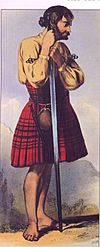Clan MacDougall facts for kids
Quick facts for kids Clan MacDougall |
|||
|---|---|---|---|
| Clann MhicDhùghaill | |||
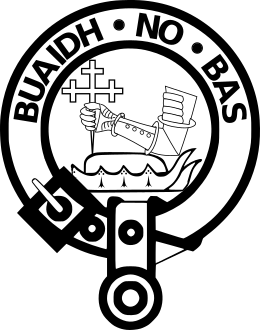
Crest: On a chapeau Gules furred Ermine, a dexter arm in armour embowed fessways couped Proper, holding a cross crosslet fitchée erect Gules.
|
|||
| Motto | Buaidh no bàs (Victory or Death), also translated as "Conquer or Die". | ||
| Profile | |||
| Region | Highland | ||
| District | Argyll | ||
| Plant badge | Bell Heather | ||
| Animal | Raven | ||
| Pipe music | "Caisteal Dhunolla" "Cumha Chaiptein MacDhughaill", "Failte Iain Cheir", "Jeanne Rea's Wedding", "Latha Dhunabharti", "Maid of Lorn", "MacDougall's Gathering", "MacDougall Gillies", "MacDougall's Lament", "MacDougall of Lunga", "MacDougall of Lunga-Paterson", "McDougall's Jig Oban Reel" |
||
| Chief | |||
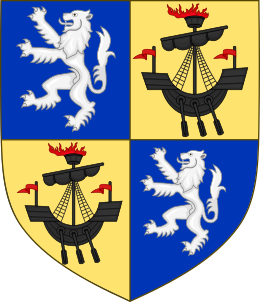 |
|||
| Morag Morley MacDougall of MacDougall and Dunollie | |||
| Historic seat | Dunollie Castle, Dunstaffnage Castle | ||
|
|||
|
|||
|
|||
|
|||
The Clan MacDougall is an old and powerful Scottish clan from the Highlands. They have lived in the Argyll area for a very long time. The clan's leader, called the Chief, is officially recognized by the Lord Lyon King of Arms. This Scottish official is in charge of heraldry (family symbols and coats of arms).
The MacDougall chiefs are related to the chiefs of Clan Donald. Both clans come from a famous 12th-century leader named Somerled. He was a Norse-Gael, meaning he had both Viking and Celtic roots. In the 1200s, Clan MacDougall was one of the strongest clans in the Western Highlands. Their chiefs were known as the Lords of Argyll and later the Lords of Lorne.
During the Wars of Scottish Independence, the MacDougalls supported the Clan Comyn. The Comyns were rivals of Robert the Bruce for the Scottish Crown. This led to battles between the MacDougalls and Bruce's supporters. Because of this, the MacDougalls lost much of their power. Other clans, like Clan Donald (who supported Bruce) and Clan Campbell (who were often enemies of the MacDougalls and Clan Donald), became more powerful.
Later, the MacDougalls supported the House of Stuart during the Scottish Civil War in the 1600s. They also supported the Jacobite risings in the 1700s, which were attempts to bring the Stuart kings back to the throne.
Contents
History of the MacDougall Clan
Where Did the MacDougalls Come From?
The Clan MacDougall gets its name from Dougall, who was the son of Somerled. When Somerled died in 1164, Dougall took control of most of Argyll. He also ruled over many islands like Mull, Lismore, Jura, Tiree, and Coll.
The name Dougall comes from the Gaelic words dubh-gall, meaning "black stranger." The King of Norway recognized Dougall's royal background. Dougall was even called 'King of the South Isles and Lord of Lorne'.
Dougall's son, Duncan, and his grandson, Ewan, built many castles. These castles helped protect their lands. Some of these were Dunstaffnage Castle, Dunollie Castle, and Duntrune Castle on the mainland. On the islands, they built Aros Castle, Cairnburgh Castle, Dunchonnel Castle, and Coeffin Castle.
Dunollie Castle is thought to have been a fort since the 500s. It became the main home for the MacDougall chiefs. Duncan also built Ardchattan Priory. This was where MacDougall chiefs were buried until 1737.
Battles with Norway
Ewan MacDougall owned lands on the islands that belonged to the King of Norway. But his mainland lands belonged to the King of Scotland. This made it hard for him to be loyal to both kings.
In 1263, Haakon IV of Norway arrived with a huge fleet near Oban. He planned to invade the west coast of Scotland. However, Ewan chose not to join the invasion. Because of old family ties, Haakon left Ewan's lands in peace.
Later, Ewan joined the Scots at the Battle of Largs. He helped attack part of the Norse fleet. The Vikings were defeated. Three years later, Norway gave all of the Hebrides islands to Scotland.
Fighting for Scottish Independence

The MacDougalls' power in Argyll led to conflicts with the Clan Campbell. In 1294, John MacDougall of Argyll led his clan against the Campbells at the Battle of Red Ford. Sir Colin Campbell was killed, and both sides lost many men.
The fourth chief of Clan MacDougall married the sister of John Comyn II of Badenoch. John Comyn's son, John Comyn III, was killed by Robert the Bruce in 1306. This event caused a major conflict between the MacDougalls and the Bruces.
Even though the MacDougalls had supported William Wallace for Scottish independence, they now found themselves in a blood feud with Clan Bruce. Robert the Bruce was also fighting for Scottish independence.
Soon after Robert the Bruce became king, he had to retreat into Argyll. He was trying to reach his allies, the Clan Campbell. But the Clan MacDougall surprised Bruce and defeated him at the Battle of Dalrigh. The king escaped, but he left behind a beautiful piece of Celtic jewelry. This was the Brooch of Lorne, which became a great treasure of the MacDougall clan.
Three years later, Robert the Bruce returned with three thousand experienced soldiers. John MacDougall of Lorne set an ambush for them. But in the Battle of the Pass of Brander, the MacDougalls were defeated and had to run away. The king then took away the MacDougalls' lands. He gave them to the Campbells because of their loyalty.
The MacDougalls never fully regained their old power. However, their situation improved under John MacDougall's grandson, John Gallda MacDougall, Lord of Lorne. In the mid-1300s, he moved back to Scotland from England. He married a niece of King David II, King of Scotland. He then got back most of the clan's original lands in Lorne.
The 1600s and Civil War
During the Civil War in the 1600s, the MacDougalls usually supported the Royalists. Their chief, Alexander MacDougall, led five hundred of his clansmen into battle.
After the Royalists were defeated, an army led by David Leslie, Lord Newark was sent to Argyll. Their job was to deal with Royalist supporters. The MacDougalls' lands were taken away again. But they were given back after the monarchy was restored in 1660.
The 1700s and Jacobite Risings
During the Jacobite rising of 1715, Clan MacDougall supported the Jacobite cause. They fought at the Battle of Sheriffmuir. After this battle, the chief had to go into exile (live outside the country). He later returned to Scotland and lived as a fugitive. He was officially pardoned in 1727.
His son, Alexander MacDougall, who became the next chief, did not join the Jacobite rising of 1745. However, his brother and some other clansmen did fight as Jacobites. They fought at the Battle of Culloden in 1746. At this time, the clan could gather about 200 fighting men.
Clan Chief
The current chief of Clan MacDougall is Morag Morley MacDougall of MacDougall and Dunollie. She is the daughter of the sister of the previous chief, Coline Helen Elizabeth MacDougall. The MacDougall chiefs are the oldest direct descendants of Somerled.
The chief's coat of arms (family symbol) shows a blue shield with a silver lion. It also has a golden section with a black ship and a red beacon. This coat of arms has been used since 1931.
MacDougall Castles
The Clan MacDougall built or owned many castles. Here are some of them:
- Dunollie Castle near Oban, Argyll. This castle is mostly ruins now, but it was once a strong tower. The site has been used as a fort since the 500s. The MacDougalls of Lorn built the current castle. The Brooch of Lorne, which was taken from Robert the Bruce, was kept here. The castle was attacked by the chief of Clan Campbell in 1644. In 1647, an army under General David Leslie attacked it again. The castle was looted and burned. During the Jacobite rising of 1715, the castle was attacked because the MacDougalls supported the Stuarts. Their lands were taken away. But the lands were given back in 1745. In 1746, the MacDougalls built Dunollie House nearby, and the old castle was left to ruin. The castle is still owned by the MacDougalls today.
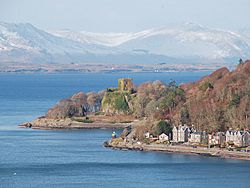
- Dunstaffnage Castle, about three and a half miles north-east of Oban, Argyll. This is a large castle with high walls and a gatehouse. Kings of Dál Riata also had a fort here long ago. The Stone of Scone (or Stone of Destiny) is said to have been kept at this castle. The MacDougalls built the current castle. Robert the Bruce attacked it after defeating the MacDougalls in 1309. Bruce then made it a royal castle, and the Campbells became its keepers. There is also a chapel nearby from the 1200s. Historic Scotland now takes care of the castle.
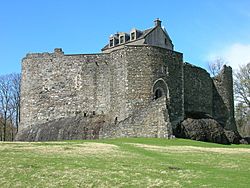
- Gylen Castle, on the south coast of Kerrera. This is a small tower house that still belongs to the MacDougalls. An earlier castle on this spot might be where Alexander II of Scotland died in the 1200s. Duncan MacDougall finished building the current castle in 1582. However, it was burned by the Covenanters in 1647, along with Dunollie Castle.
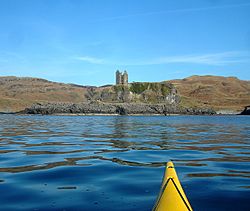
- Cairnburgh Castle, on the Treshnish Isles, off the Isle of Mull. This is a ruined castle that the MacDougalls once held. It became Crown property in 1309, with the MacDougalls as keepers.
- Dunchonnel Castle, on the Garvellach Isles. This is a ruined castle that was once held by the MacDougalls.
- Coeffin Castle, on the Isle of Lismore. This is a ruined castle that the MacDougalls once held.
- Duart Castle, on Mull. The MacDougalls probably built this castle in the 1200s. It later came into the possession of the MacLeans in the 1300s.
- Mingary Castle in Lochaber. The MacDougalls may have built this castle in the 1200s. This shows how far north their power reached.
Tartans

- MacDougall (Modern)
- MacDougall (Ancient)
- MacDougall (Dress)
See also


